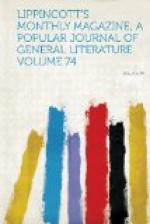I have not left myself room, I fear, to say anything on the present occasion of the other highly interesting collections which are at present lodged, or in the course of being placed, under the all-sheltering roof of the Collegio Romano. I must content myself with simply enumerating them, with the hope of giving some account of them at some future time. I may briefly state, then, that the celebrated Kircherian Museum, formed toward the close of the sixteenth century by the learned Jesuit father Kircher, still occupies the rooms on the ground-floor, with a somewhat improved arrangement, which it occupied when the fathers of the Company inhabited the building. The collection of ancient Roman marbles discovered in the excavations of the buried city of Ostia have been brought thence, and arranged in rooms also on the third floor—a fact which strikes one as not a little to the credit of the handiwork of Ammanati, the Florentine architect. Also on the third floor there is an exceedingly interesting collection, of which I hope to speak somewhat more at length another time. It is called a palaeo-ethnographical museum, and consists of a large collection of the implements of all sorts of the people belonging to the pre-historic period, together with a similar gathering of articles used by the uncivilized races of the present day. The interest of such a comparative study as is here suggested is, as may be readily understood, very great. On the fourth floor there is a very considerable collection of objects illustrating Italian art of the ante-Roman period, and also a Museum of Industrial Art, conceived on the plan of the English School of Art at South Kensington.
T.A.T.
TRADES UNIONISM IN ITS INFANCY.
In these days of trades unionism and strikes an account of the germ of such associations in this country is not without interest. So far back as 1806 a remarkable trial arising out of such a combination took place before the recorder of Philadelphia and a jury. It lasted three days and excited extraordinary interest. Jared Ingersoll and Joseph Hopkinson were counsel for the prosecution, and Caesar A. Rodney and Walter Franklin for the defence.
The defendants, eight in number, were indicted for not being content to work at the usual prices, but contriving to increase and augment them, and for endeavoring to prevent by threats, menaces and other unlawful means other artificers from working at the usual rate, and uniting into a club or combination to make and ordain unlawful and arbitrary rules to govern those engaged in their trade, and unjustly exact great sums of money by means thereof.




